How to make high beds
You will be surprised by your past doubts - whether to make high beds at the cottage ... Your back will be grateful to you - you will simply bend down to care for the bed. Your knees will be grateful to you - you can just sit on the edge of the garden and take care of your garden. Your plants will be grateful to you - there is no more competition between weeds or the nearest fruit trees. Your land will be grateful to you - you do not trample it and ennoble it with humus. Your garden with high beds can look beautiful, comfortable and generously thank you for the harvest.

How to make high beds with your own hands.
1. First, we must mark the place for the beds. The usual bed width is 1.2 m, length can be any. Mark the rectangles of the desired size on the ground with sand.

2. We collect high beds. The high bed has no bottom and consists of columns with grooves on all four sides and boards with corresponding grooves. You can buy ready-made fence for the beds or make them yourself. For fencing it is better to take hardwood, because conifers produce resin, which may have an unnecessary effect on soil composition. Check the horizontal installation of the garden box level.

3. We extend the high beds. Because we have modular beds, we can extend our beds on either side with another module.

4. How to protect a high bed from rodents. Even if you didn’t encounter moles and other underground garden pests in your summer cottage, it’s better to provide protection for your garden right now than to struggle unsuccessfully with this rodent. At the bottom of each box we place a metal grid so that it goes a little on the edges of the fences.

5. How to protect the soil on a high bed from leaching into the main soil. To do this, we use ordinary packaging cardboard in two layers so that it covers the entire bottom of our garden box. If there are not enough solid pieces, we use cardboard trimming — we fasten them with a stapler with the main piece so that the cardboard at the bottom of the box does not move when filling the soil.

6. The soil for high beds should be light, crumbly and "fluffy." You can easily check its quality by sticking a finger into the ground - if it sinks to the third joint - this is the norm. To improve the composition of the soil, you can add peat or compost. We pour the soil into the garden box, check its horizontal level, pour it over to compact it a little. During the season we will need to pour a little soil.

7. Irrigation system for high bed. It is planned to fasten a garden hose with nozzles for irrigation along the contour of high beds: we need 90 and 180 degree dividers.

8. Lanes for high beds. Because the land in the high bed is loose, then it will not be possible to install a trellis in it, therefore we fix the trellis from PVC pipes into the ground next to the garden box. On the trellis we stretch nets for climbing plants-gherts and beans. For tomatoes we install lightweight steel rod supports.

What you need to know when building a high bed.
1. Try to protect the high beds from the strong wind and heat, creating a penumbra for them with a trellis of flowers or tall shrubs.
2. The long side of the bed should look towards the south - this way the plants will be evenly illuminated, otherwise, higher plants will shade others.

3. The density of planting on a high bed is two times higher than on a normal one. So plants struggle with weeds and create foliage moist microclimate.

4. High beds with sides will allow feasible care for the garden for the elderly or people with a problem back.

5. High bed - warm bed. This bed warms up faster in the spring and if you make a mini greenhouse based on it, it will surprise you with an early and generous harvest.
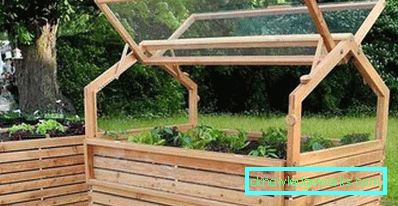
6. Divide the long high bed with cross-section struts into square segments - this will reduce the soil pressure on the side walls of the bed.

Fences for high beds.
1. Most often for clear beds use fencing made of wood. There are a few points here - do not use boo tree, especially sleepers, which may contain harmful chemicals. Do not treat fresh wood with protection products if you are not sure of their full environmental safety.

2. Wattle as a fence for high beds. For all its environmental friendliness, such a fence has three significant drawbacks - the soil in the garden quickly dries from the wind, the insulation of the garden is not properly insulated, the soil can pour out through the cracks. Everything is fixable - use a layer of double cardboard around the inner perimeter of the fence. Environmentally friendly, the air gap between the sheets serves as heat insulation, the earth no longer gets enough sleep.

3. As a fence for high beds, you can use metal profiles, including from the old roof or fence.
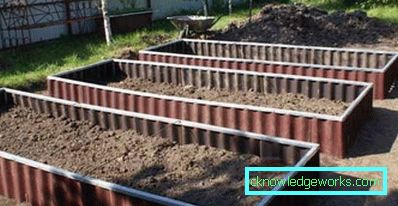
5. You can make fences for high beds with your own hands from brick or concrete. This is a very good option, but you need to consider that concrete for 2-3 years will affect the acidity of the soil in the garden.
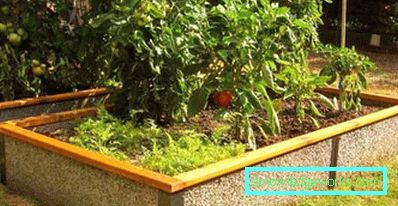
6. The best fences for high beds - plastic. They do not emit anything of their own in the soil, excellent thermal insulation, long service life and the ability to specify any shape of the beds, unlike standard rectangles of beds with wooden fences.

7. Fences for high beds made of scrap materials. You can make the sides of the beds out of bottles, arranged as bricks on a concrete solution.

Why need high beds.
High beds allow you to increase the area under the garden because uncomfortable slopes or poor or clogged soil can be used. High beds allow an eco-friendly way to fight weeds and soil erosion.
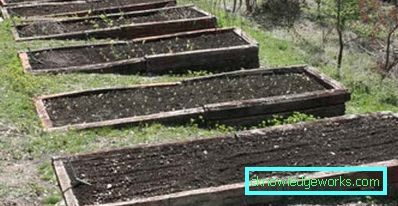
These beds warm up faster and give an earlier harvest. They allow more economical use of moisture for irrigation.

Various types of high beds.
In addition to the traditional high beds with high sides, there are several types of high beds.
1. Circular high bed. Consists of a round frame, in which there is a path to the center of the garden. This form of high beds is also called "keyhole".

At the bottom of the beds put branches, roots, paper, compost. In the middle of the garden there is a tunnel for fresh organic waste and water.

This design beds provides the desired moisture and continuous enrichment of the soil.

2. High bed without fences. When constructing such a bed, the first layer of trees (not conifers), branches, roots, and snags fall into the ground to a small depth; the second layer is this turf removed from the place where you make the bed laid down with grass; the third layer is 20-30 cm of basic soil mixed with humus.

For irrigating loose high beds, an irrigation irrigation system is used when water comes from the ditch between the beds — a good option for flooded gardens in the spring, or you can use the drip irrigation option when water enters the garden bed from mini terraces.

The paths between the beds are covered with straw or large sawdust. Never step on the ground on a high bed - so you seal it, and it will be harder for plants to get moisture and nutrients.
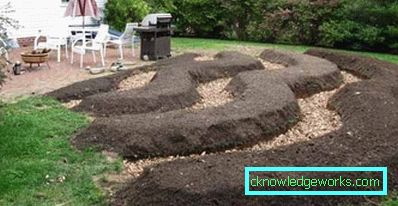
High beds of this type can be used not only for the garden, but also for the cultivation of shrubs and fruit trees, if you have troubled soil on their summer cottage. The life of such a bed (until the first tree layer with trunks completely decays) is 20-25 years - any fruit tree will have enough time to live.

Do not regret the space for paths between high beds - so you can always go there with a garden wheelbarrow both for harvesting and for a new portion of humus. Have pity on your back - use a wheelbarrow.
If your high beds are located near fruit trees, you may need to establish a root barrier before breaking up the beds — dig a trench, cut the root at the approach to the beds, install a metal sheet in the trench, and prevent the root from growing in this direction.

Learn more about high beds through your own experience. There are many interesting finds, experiments and new discoveries for each gardener in this topic.
And we have prepared for you a video with 100 inspiring examples of the use of high beds in the country.
Cottage with Your Hands